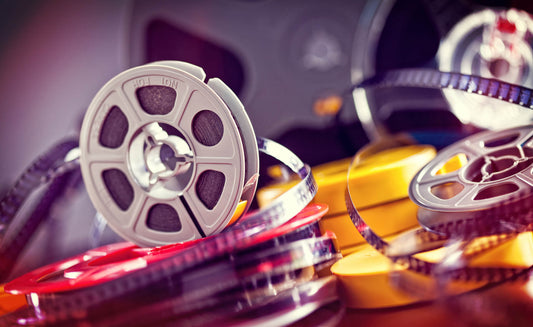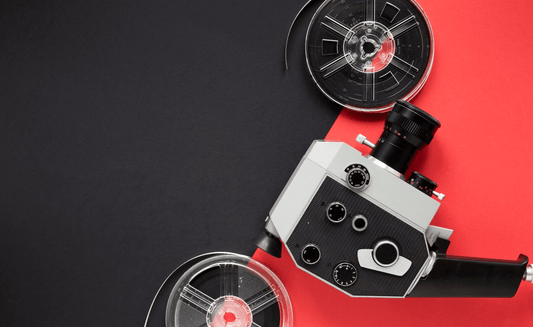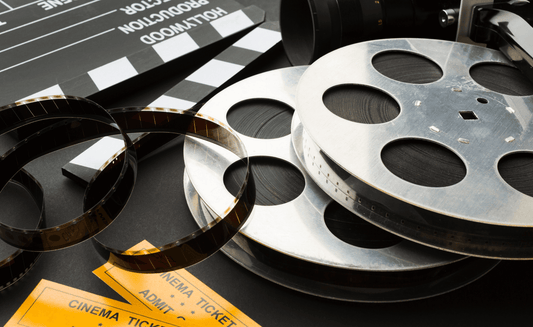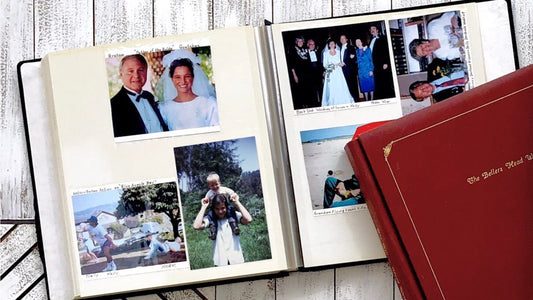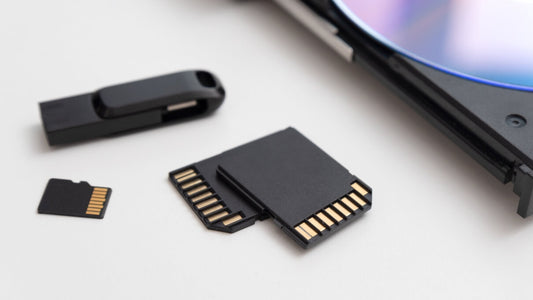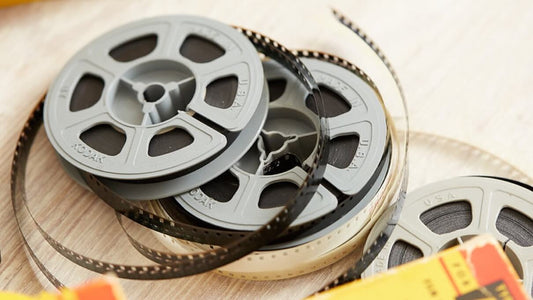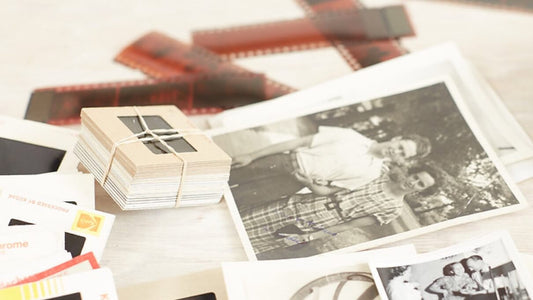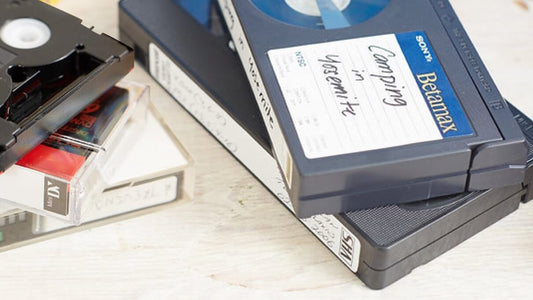In 2023, we all have unlimited films, tv shows, and family home movies at the touch of a button, but before digital technology film reels were the best, and for a while the only way to store film in a compact way while also preparing it for projection. However, there; s a lot more to the answer to the question, “What is a film reel?”
For over 2 decades, Capture has been preserving 16mm, 8mm, and Super 8 film contained on film reels as well as loosely stored film, so our experts understand film reels more than most people. We wanted to share that information with you in this blog.
Keep reading to learn about the history of film reels, the types of reels, what they are made of, how they work, and everything else you need to know about storing and preserving film reels.
Jump to:
- History of Film Reels
- Types of Film Reels
- Components of a Film Reel
- Analog vs. Digital Film Reels
- How Film Reels are Made
- Storing and Preserving Film Reels
History of Film Reels

Film reels in motion pictures are a circular design that looks similar to a wheel and have evolved to be a symbol of the Hollywood film industry. However, the answer to “What is a film reel?” could also refer to a demo reel or showreel, but this blog will be discussing the circular device used for movie theater features.
Not long after when the first video was recorded, Edison invented a camera made for motion picture filming in 1892. This camera had two reels that were the predecessor to reel-to-reel projectors, but in this time period it was used to capture films on the strips of plastic film base coated in gelatin emulsion with silver halide crystals.
This invention would eventually evolve into the movie industry and during the early 1900s, everything was recorded onto film reels. This includes television shows, feature films, and much more. Film reels made it easier to store film while also providing a way to project it to movie theaters full of people. In fact, the motion picture industry as we know it would not be the same without the use of film reels.
Eventually, it completely transformed the movie industry and even influenced amateur film formats including the 16mm film format introduced by Eastman-Kodak in 1923. While you can figure out how to view 16mm film without a projector, the reels make it possible to simply use a projector to display the home movies.
This led to other film formats like 8mm cameras that simplified the process introduced with the 16mm film format. While these older formats could only capture silent films, feature movies added a synchronized sound. However, it wasn’t until the invention of what is Super 8 film that sound recording became easily accessible for capturing video family memories.
Up until the invention of VHS tapes (that stand for Video Home System) and use magnetic tape, these old film types were the prominent way to record moving memories. Later, the invention of the first digital camera was the beginning of the end for these types of analog video formats and vintage camcorders.
Types of Film Reels

As you can see, the history of what is a film reel is quite long and the list of types of film reels starts by understanding film reel sizes. Film reel spools were originally designed to hold approximately 1,000 feet of 35mm motion picture film and ran for a duration of about 10 minutes.
That meant that films used multiple reels, but as film reels progressed to become the primary method for how to store film, more reel sizes and film sizes create different reel types. That way, a whole movie could be stored on a single reel instead of relying on two-reeler, three-reeler, or other multiple-reel combinations to show an entire movie.
For example, 16mm film reels usually hold 50 to 800 feet, typically without audio. They also contain sprockets only on one side of the film, unlike silent films on 35mm reels. 8mm film reels on the other hand offer about twice the duration of playback as a 16mm reel of the same size.
When it comes to 8mm vs Super 8, the film reels were the same size, but Super had a higher picture quality and was more likely to have sound capability with a rust-colored strip on the edge of the film base. So, to put it simply, each type of film would have its own type of reel, but size is another way to categorize film reel types.
Film reels are measured by diameter, and you can check out the following table to learn about different film reels for standard 8mm film, Super 8 film, and 16mm film.
| Film Reel Width | Film Length | Approximate 8mm and Super 8 Running Time | Approximate 16mm Running Time |
|---|---|---|---|
| 3 inches | 50 feet | 3 minutes | 1 minute |
| 4 inches | 100 feet | 6 minutes | 2 minutes |
| 5 inches | 200 feet | 12 minutes | 6 minutes |
| 6 inches | 300 feet | 15 minutes | 8 minutes |
| 7 inches | 400 feet | 24-25 minutes | 12 minutes |
| 10.5 inches | 800 feet | 45-55 minutes | 25-30 minutes |
| 12 inches | 1200 feet | N/A | 40-45 minutes |
| 14 inches | 1600 feet | N/A | 45-55 minutes |
| 16 inches | 2000 feet | N/A | 60-74 minutes |
Components of a Film Reel

Film rolls consist of the emulsion and base that compose the film itself. Old video cameras for film would expose the silver halide crystals to light, which would darken the emulsion and form an invisible image. This image would be developed with chemical baths producing the photographic image.
This is virtually the same process used for photographs, photo slides, and other types of analog photography, but with motion picture film the perforations attach it to a film reel to play as a motion picture on a project.
When a projectionist uses a film reel during the silent era, they would have to move one standard length reel to another. The sprockets are used to hold the spool of film onto the projector. As it spins, the spool unwinds and displays it in from of the projector lamp.
Then there are the hubs and flanges that make up the final components of the reel. Typically, the hubs hold a circular shape for smooth spinning during projection. That way, the entire film reel can retain its quality and functionality for years, as long as the film itself isn’t damaged, brittle, or worn out.
Analog vs. Digital Film Reels

The significance of film reels in cinema cannot be overstated, but the era of film reels has long been gone. That’s because digital films no longer require film reels and in general movie theaters no longer use film reels at all.
Digital projectors are much more common, and it makes sense because it’s more compact, cheaper, and can quickly be edited. You can affordably add overdubbing or subtitles for English, Spanish, Japanese, French, or other languages.
Most of the world has been digitizing home movies, changing from analog to digital, leaving analog footage behind and Hollywood is no exception. So how do theaters get exclusive new releases? Distributors pack the releases in plastic cases called Digital Cinema Packages that consist of a hard drive with the movie files on it. This requires a license for activation so that a projectionist can play it for audiences.
Still, some filmmakers still prefer to use film reels. This might be because it’s just what they are used to from learning it before the digital age, but others like the ability to add practical effects due to the way film reels work. Finally, nostalgia can be a powerful incentive to stick to old film reel formats.
How Film Reels are Made

The most complex part of how film reels are made is the way that film works in general. We already referred to it earlier, but basically the film tape has layers that produce contrasting colors when exposed to light. This is done through chemicals like silver halide and gelatin.
Sound is recorded on old film formats by using a variable-area soundtrack process, or SVA. This allows sound to be recorded on a transparent line along the movie film. If you don’t know how a projector works, it basically shines light through the images on the film reel.
The film reel will basically move at a certain speed to display the projected image onto a screen at the right speed. When the light passes through the film on a photodetector, it changes the light to an electrical current and sends this to a pre-amplifier which produces the sound.
So, to create this audio and visual effect, the film undergoes light exposure and the development process. After the development of film reels, that’s done similarly to any other type of development process including how to develop a disposable camera, the strips of motion picture film will be attached to the film reels. That’s the basic manufacturing process of film reel components.
Storing and Preserving Film Reels
To ensure the movie industry and film reels last as long as possible, they need to be stored in a cool, dark, dry place. If you’re wondering how long film lasts, it can last as little as 2 years or longer than 25 years. Storing it properly will help extend the lifespan by ensuring that light doesn’t fade the images or humidity doesn’t warp the film layers or spools.
Additionally, it’s always smart to preserve any analog formats as digital copies. So, if you have film footage captured with a Super 8 camera then it’s wise to digitize it. That doesn’t mean you have to get rid of the original copy, but it will make sure that the footage and precious memories will last forever.
You can figure out how to digitize Super 8 film and other film types on your own, or you can choose one of the best companies to digitize home movies to do it professionally for you. Either way, this guarantees that your memories are never lost and will continue as digital heirlooms or gifts for grandpa, grandma, parents, children, and future generations.

Conclusion
If you’ve ever wondered, “What is a film reel?” now you know that film reels are basically just photography kept on a spool to display on a projector at a certain speed to mimic motion. While this format has largely been replaced by digital videos, it greatly influenced the Hollywood industry and film reels still exist in people’s collections and archives.
However, film can only last forever if you digitize it. Capture offers decades of experience digitizing film, and we’ll automatically integrate your digital footage with your Google Photos account. Click here to learn about our film transfer services!


